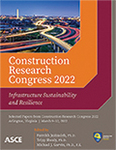Power Infrastructure Resiliency and Maintenance Planning: The Socioeconomic Impact of Disruptions to North Carolina Power Infrastructure
Publication: Construction Research Congress 2022
ABSTRACT
A community’s overall resilience depends on the resilience of its infrastructure as well as its social and economic institutions. Each of these institutions are typically evaluated and modeled as separate entities and assessed individually to illustrate a community’s resilience to extreme events. While there has been work dedicated to how vulnerable populations are disproportionally impacted by extreme weather events, very little has been done to model how infrastructure systems and their day-to-day failures impact the socioeconomically vulnerable, and to what extent. Power utility construction planning, not only in terms of generation expansion and resiliency, but also in terms of public welfare, offer great opportunities for investigation and improvement. It has been theorized that energy justice can offer a decision-making tool that can assist energy planners and consumers in making more informed energy choices. This paper presents a preliminary analysis of an ongoing study that aims to understand how the socioeconomically vulnerable are impacted by power infrastructure failure in North Carolina. This paper describes an ongoing study that aims to identify (1) location specific trends of failed power infrastructure and (2) the North Carolina counties and associated socioeconomic factors that are disproportionally affected by failure events in terms of the duration of failure events.
Get full access to this article
View all available purchase options and get full access to this chapter.
REFERENCES
Alguacil, N., Carrión, M., and Arroyo, J. M. (2009). “Transmission network expansion planning under deliberate outages.” International Journal of Electrical Power & Energy Systems, 31(9), 553–561. https://doi.org/10.1016/j.ijepes.2009.02.001.
ASCE. (2021). “Report Card for America’s Infrastructure.” at https://infrastructurereportcard.org/cat-item/energy/.
ASCE, EBP, and Advisors, D. E. (2020). “Failure to Act: Electric Infrastructure Investment Gaps in a Rapidly Changing Environment ” at https://www.asce.org/uploadedFiles/Issues_and_Advocacy/Infrastructure/Content_Pieces/Failure-to-Act-Energy2020-Final.pdf.
Burger, B., Gochfeld, M., Pittfield, T., and Jeitner, C. (2017). “Responses of a vulnerable Hispanic Population in New Jersey to Hurricane Sandy: access to care, medical needs, concerns and ecological ratings.” J Toxicol Environ Health Part A, 80(6), 315–325.
Campbell, R. J. (2018). Weather-related power outages and electric system resiliency. Congressional Research Service, Washington, D.C.
Cimellaro, G. P., Reinhorn, A. M., and Bruneau, M. (2010). “Framework for analytical quantification of disaster resilience.” Engineering Structures, 32, 3639–3649.
Cutter, S. L. (2003). “Social Vulnerability to Environmental Hazards.” Social Science Quarterly, 84(2), 242–261.
Department of Homeland Security. (2013). NIPP 2013: Partnering for Critical Infrastrucure Security and Resilience.
Duke Energy. (2021). “Outages in the Carolinas ”. https://outagemap.duke-energy.com/#/current-outages/ncsc.
ESRI. (2021). “What is GIS?”. Available at https://www.esri.com/en-us/what-is-gis/overview. Accessed.
FEMA. (2017). “Power outage incident annex to the response and recovery federal interagency operational plans: managing the cascading impacts from a long-term power outage.” at https://www.fema.gov/media-library/assets/documents/154058.
Ferreira, F. H., Vega, J. R. M., Barros, R. P. D., and Chanduvi, J. S. (2008). Measuring inequality of opportunities in Latin America and the Carribean. The World Bank.
Flanagan, B., Gregory, E., Hallisey, E., Heitgerd, J., and Lewis, B. (2011). “A Social Vulnerability Index for Disaster Management.” Journal of Homeland Security and Emergency Management, 8(1). https://doi.org/10.2202/1547-7355.1792.
Ganin, A. A., Massaro, E., Gutfraind, A., Steen, N., Keisler, J. M., Kott, A., Mangoubi, R., and Linkov, I. (2016). “Operational resilience: concepts, design and analysis.” Scientific Reports, 6(1), 19540. https://doi.org/10.1038/srep19540.
Gass, V., Schmidt, J., Strauss, F., and Schmid, E. (2013). “Assessing the economic wind power potential in Austria.” Energy policy, 53, 323–330.
GRASP. (2020). “CDC SVI 2018 Documentation.” at https://svi.cdc.gov/Documents/Data/2018_SVI_Data/SVI2018Documentation.pdf.
Jenkins, K. E. H., Heffron, R., McCauley, D., Graaf, T., Sovacool, B., Ghosh, A., and Klare, M. (2016). The Political Economy of Energy Justice in Canada, the UK and Australia: A Nuclear Energy Perspective, Palgrave.
Klinger, C., Landg, O., and Murray, V. (2014). Power outages, extreme events and health: a systematic review of the literature from 2011 to 2012.
Kraushar, M., and Rosenberg, R. (2015). “A community led medical response effort in the wake of Hurricane Sandy.” Disaster Med Public Health Prep, 2(4), 354–358.
Mitsova, D., Esnard, A.-M., Sapat, A., and Lai, B. S. (2018). “Socioeconomic vulnerability and electric power restoration timelines in Florida: the case of Hurricane Irma.” Natural Hazards, 94, 689–709. https://doi.org/10.1007/s11069-018-3413-x(0123456789.,-volV)(0123456789.,-volV).
National Academy of Engineering. (2014). Greatest Engineering chievements of the 20th Century.
National Academy of Sciences. (2012). Disaster Resilience: A National Imperative, National Academic Press, Washington D.C.
National Academy of Sciences. (2013). Emerging Workforce Trends in the US Energy and Mining Industries: A call to Action. National Academic Press, Washinton D.C.
National Infrastructure Advisory Council. (2013). “Strengthening Regional Resilience through National Regional and Sector Partnerships: DRAFT Report and Recommendations.” at http://www.dhs.gov/sites/default/files/publications/niac-rrwg-report-final-review-draft-for-qbm.pdf.
Rodgers, M., Coit, D., Felder, F., and Carlton, A. (2019). “Assessing the effects of power grid expansion on human health externalities ” Socio-Economic Planning Sciences, 66, 99–104.
Roege, P. E., Collier, Z. A., Mancillas, J., McDonagh, J. A., and Linkov, I. (2014). “Metrics for Energy Resilience.” Energy Policy, 72, 249–256.
Siyal, S. H., Mentis, D., and Howells, M. (2016). “Mapping key economic indicators of onshore wind energy in Sweden by using a geospatial methodology.” Energy conversion and management, 128, 211–226. https://doi.org/10.1016/j.enconman.2016.09.055.
Sovacool, B. (2013). Energy & Ethics: Justice and the Global Energy Challenge, Palgrave, Basingstoke, UK/New York, USA.
Sovacool, B., and Dworkin, M. (2015). “Energy Justice: Conceptual insights and practical applications.” Applied Energy, 142, 435–444.
The National Academies Press. (2012). Disaster Resilience: A National Imperative. The National Acadamies Press, Washington, DC, USA Available.
Thomas, J. E., Eisenberg, D. A., and Seager, T. P. (2018). “Holistic Infrastructure Resilience Research Requires Multiple Perspectives, Not Just Multiple Disciplines.” Infrastructures, 3(3). https://doi.org/10.3390/infrastructures3030030.
Information & Authors
Information
Published In
History
Published online: Mar 7, 2022
Authors
Metrics & Citations
Metrics
Citations
Download citation
If you have the appropriate software installed, you can download article citation data to the citation manager of your choice. Simply select your manager software from the list below and click Download.
